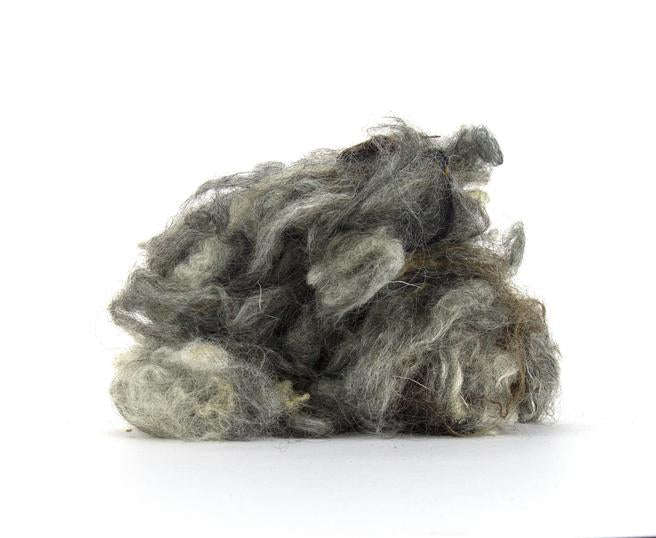Hi everyone. I was remembering how confusing it was for me when I first started needle felting six years ago. Roving, Tops, Carded, Locks, Merino, etc and I had no real idea of what any of them were! This meant I ended up learning by my (expensive) mistakes. Sooo I have put together a guide for you lovely lot in the hope that it will help. It is by no means a definitive list, it just deals with the wools I now use and how I use them. (click here for my handy booklet to print and keep)
-BREEDS OF SHEEP-
Different breeds of sheep produce different thickness (micron) of wool. As a general rule:-
MERINO sheep give fine wool - good for adding fine detail but for needle felting it really does need to be ‘carded’ merino or it will take forever to felt BEWARE there are lots of wonderful colours of Merino available to buy but the chances are it won’t be carded and so will be unsuitable for starting in needle felting. Even carded merino can be tricky to needle felt and is best for pictures or a fine top layer to 3d objects
NEW ZEALAND sheep fine-medium - good for needle felting, gives a smooth finish. Also fine enough to be perfect for creating needle felted 2d (flat) pictures or ‘Painting With Wool’ as it is often called
CORRIEDALE Sheep medium – highly recommended for 3d Needle Felting shapes – we use this in all our 3d workshops and gives a natural finish. More advanced felters may use this for the core shape and then use a finer wool for the top layer
BERGSCHAF Sheep medium-course – fast felting with a ‘hairier’ finish. The coarseness of the wool is measured in microns so the higher the micron the courser the wool. The first thing is to decide on the breed of sheep and then make sure the wool has been processed into the best form for your requirements (ie usually CARDED for needle felting)
-TERMINOLOGY/PROCESSES-
RAW/ ‘IN THE GREASE’ Wool that is more or less just as it comes off the sheep during shearing! It may have been picked over to remove the worse of any dirt or vegetation but it will still have a strong sheep smell and will require washing (scouring) before use
SCOURED Wool that has been washed to remove a lot of the grease and dirt
FLEECEWOOL Wool that is more or less as it comes off the sheep with minimum processing
LOCKS The curliest bits from the fleece. These can be natural (undyed) and also be found in a rainbow of colours
NEPS Also known as KNOPS! Small balls of tangled fibres that are often used in fibre art to add texture to a piece
SLUBS Little rolls of tangled fibres
TOPS and ROVING These are the same thing! The term ‘tops’ is usually used in the UK and ‘roving’ in other countries. BEWARE - All the fibres have been combed in one direction which can make it much more difficult to needle felt into a 3D shape. GOOD FOR - applying a top coat of fur/hair to felted animals
CARDED This is wool that has been combed and roughed up in all different directions making it much easier to needle felt with. Carded Wool comes in the form of 'batts' and also in 'slivers'
SLIVERS Slivers are carded wool that has been formed into a long thin tubular rope-like piece and comes in a roll. GOOD FOR - knotting and then wrapping round the knot to start your core body off. Also because they are long, thin pieces they are good for wrapping around armature (a wire skeleton)
BATTS/BATTING Carded wool exactly the same as in slivers but it comes off the carder in a thick sheet or pad. To start a core body you pull off strips and roll tightly then needle felt to hold together
MELANGE wool that has a mix of colours in it
CORE WOOL This is carded wool that is usually an undyed natural colour. Unless I am making something tiny then I will use the cheaper undyed wool to form my shape then use the more expensive and perhaps finer carded wools to finish. I tend to use undyed natural carded Corriedale slivers as my core as being able to tie a knot and then wrap round speeds everything up, it has got very little bits of vegetation mixed in it and gives a nice smooth finish ready to take the top layer. Some wool sold as ‘core’ comes in a big fluffy cloud rather than a batt or a sliver. 100g of carded Corriedale slivers is enough to make three good Christmas bauble sizes to give you an idea how much you use
OUR FAVOURITES FOR 3d FELTING :-
Carded Corriedale Slivers can be used as core and top coat - it is economical, felts fast and gives good even results. This is a good allrounder.
Carded New Zealand Maori/Bergschaf Melange gives a slightly finer finish than the Corriedale and is great for 3d felting and comes in a beautiful range of colour blends.
OUR FAVOURITES FOR 2d PICTURE FELTING :-
Carded New Zealand Maori Batts this is a finer wool at 27 microns with short fibre lengths so makes it perfect for Painting with Wool and producing picture portraits.
Carded New Zealand Extra Fine Merino Batts is perfect for adding very fine, smooth detail.
We stock all our favourites above; they are not our favourites because we stock them, we stock them because they are our favourites and the best we have found!






Leave a comment